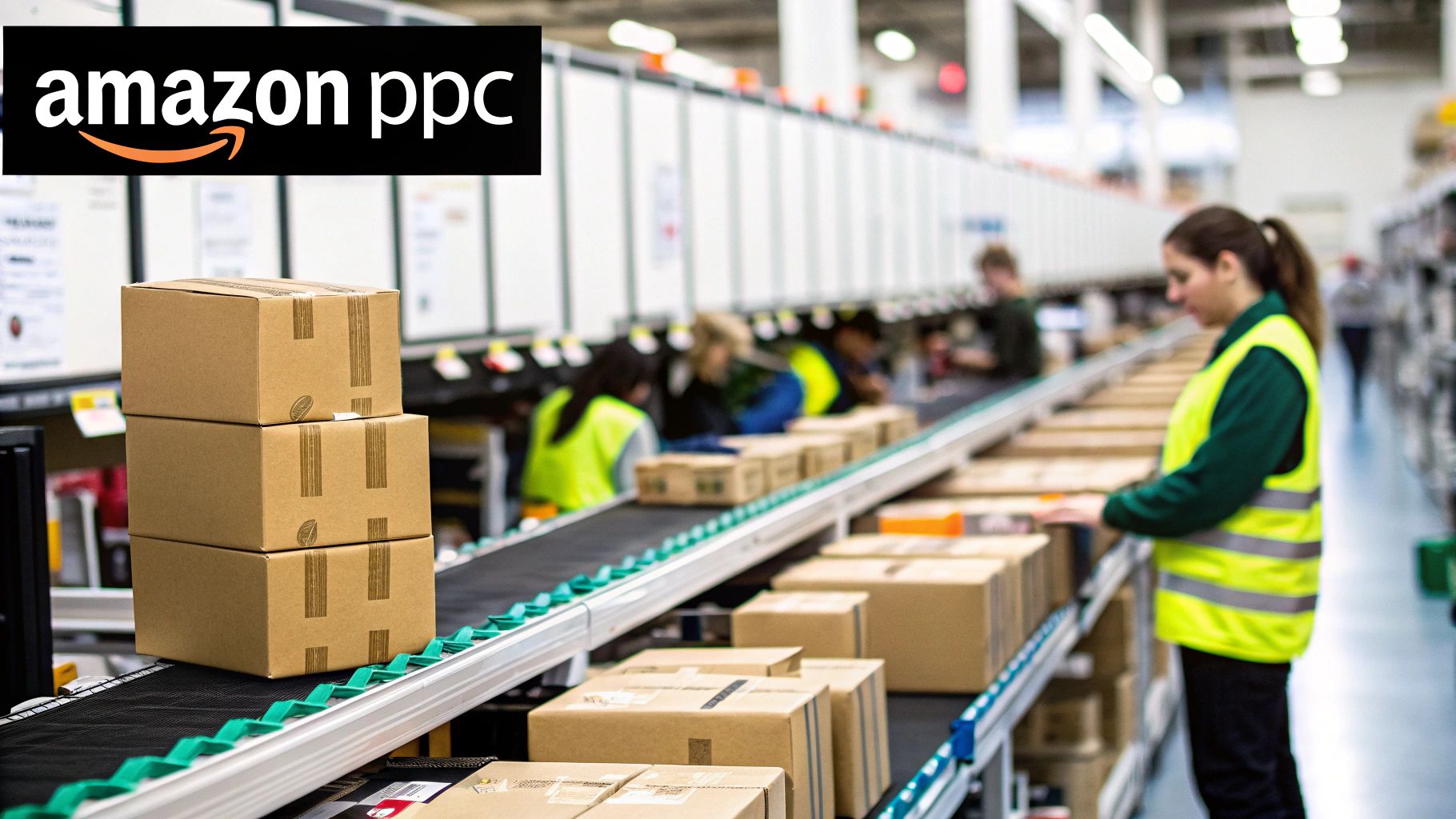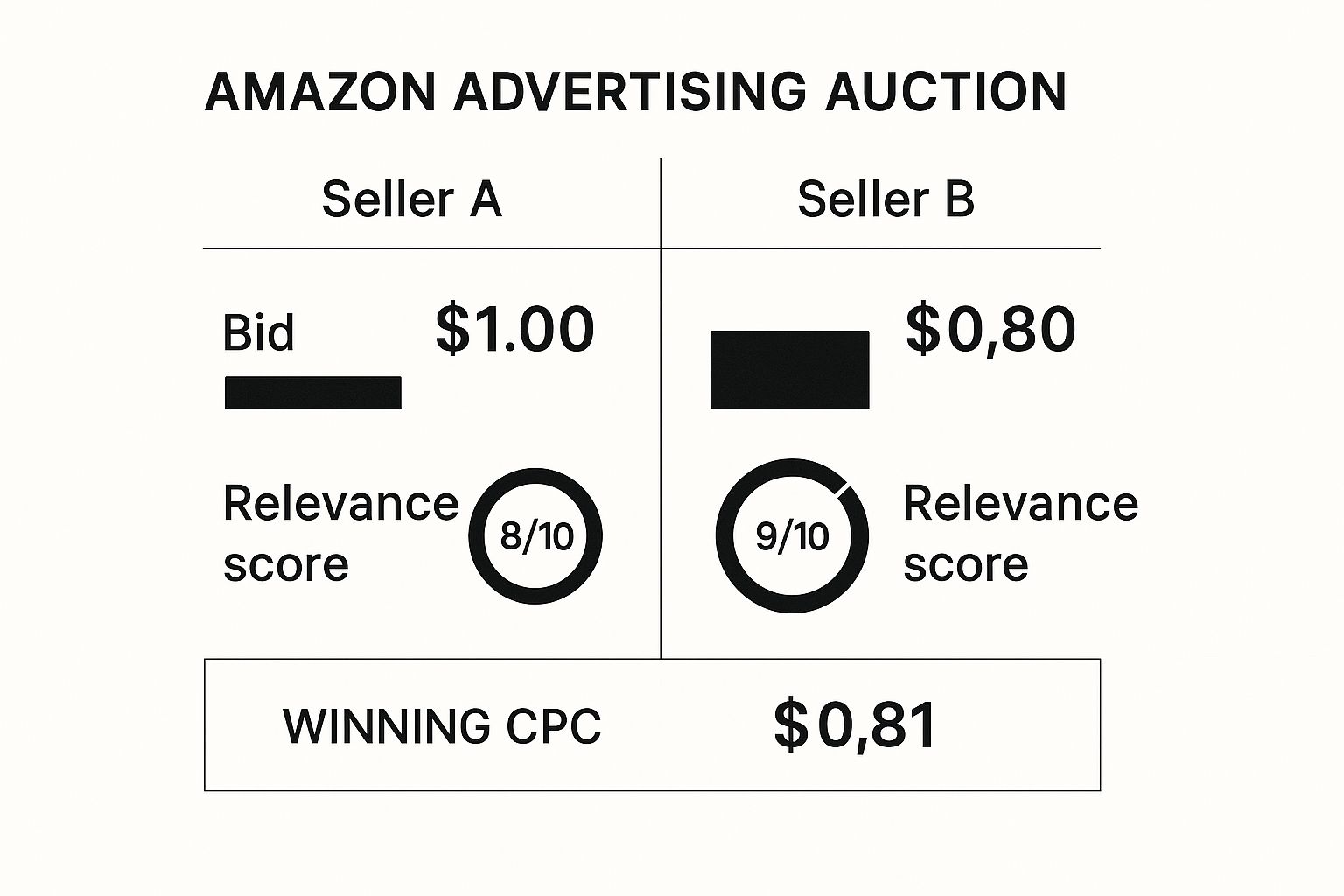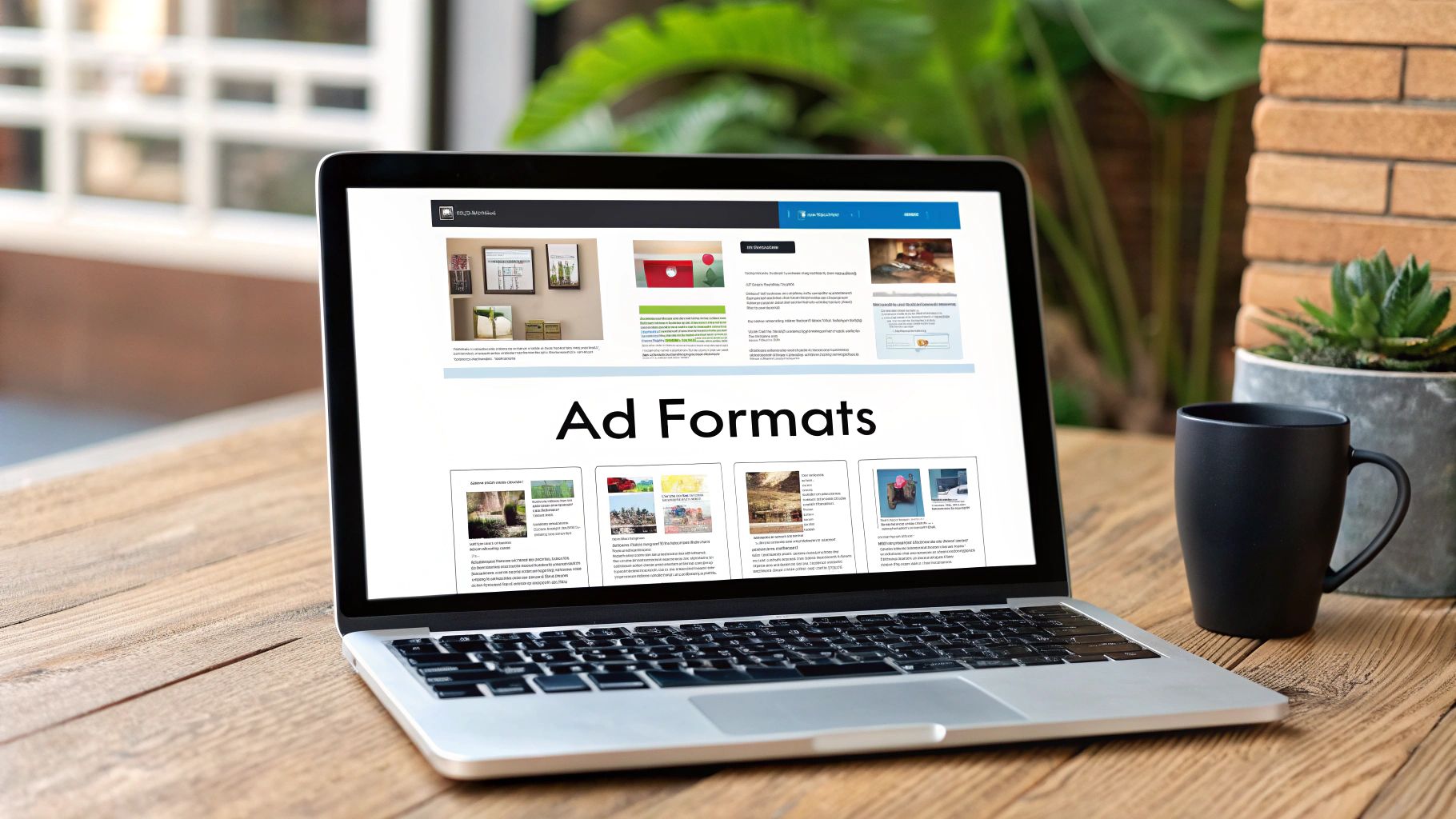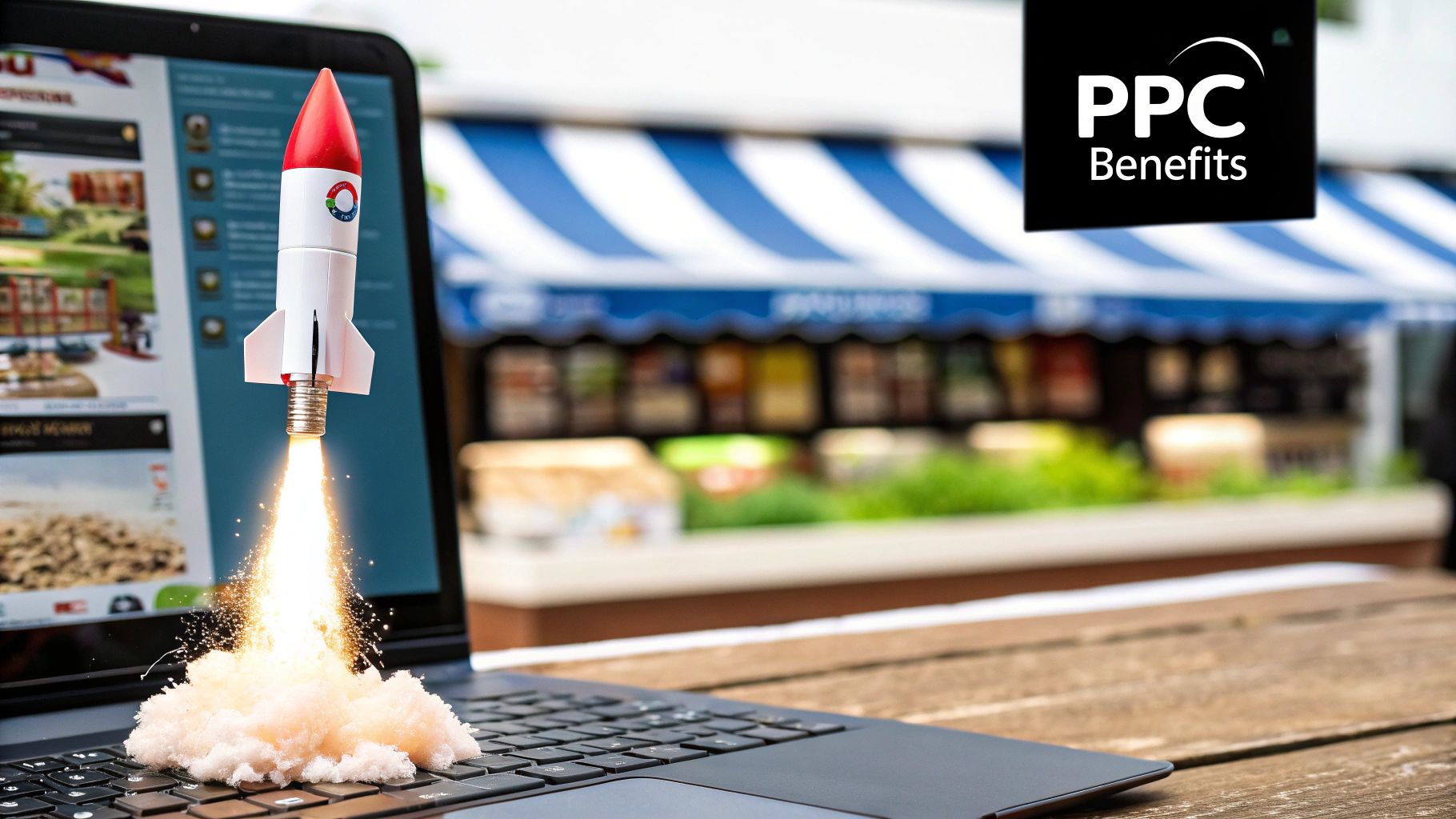Amazon PPC (Pay-Per-Click) is exactly what it sounds like: an advertising model where you only pay Amazon a fee when a shopper actually clicks on your ad.
Think of it as renting a premium, eye-level shelf in the world’s largest digital store. You get to place your products directly in front of motivated buyers at the exact moment they’re searching for them.
Decoding Amazon Pay Per Click Advertising

So, what does that look like in practice? It’s a performance-based system designed to give your products immediate visibility. Instead of waiting weeks or even months to slowly climb the organic search rankings, you can pay to appear at the top of the search results page right away.
This is a game-changer for new products or for anyone trying to break into a competitive category where getting noticed feels next to impossible.
The whole thing runs on an auction system. You tell Amazon the maximum amount you're willing to pay for a click on certain keywords. Amazon then takes your bid, considers how relevant your ad is to the shopper's search, and decides where to show it.
The Core Purpose of PPC
At its heart, Amazon PPC isn’t just about making a quick sale. It’s a powerful tool for building long-term growth and gathering priceless market intelligence. The real strategic goals usually boil down to a few key things:
- Boosting Sales Velocity: Driving those critical initial sales for new products, which helps improve their organic ranking over time.
- Increasing Brand Awareness: Getting your brand and products in front of a much wider audience who might never have found you otherwise.
- Launching New Products: Gaining immediate traction and customer feedback without having to wait for organic discovery to kick in.
The proof is in the numbers. In the US, Amazon now captures 22.3% of all search ad spending. And with over 98% of consumers researching products online before they buy, being visible where they're looking is everything.
To help you get a quick handle on the terminology, here’s a simple breakdown of the core components.
Amazon PPC at a Glance
| Component | Brief Explanation |
|---|---|
| PPC | Pay-Per-Click. An advertising model where you pay a fee each time someone clicks your ad. |
| Keyword | The specific word or phrase a shopper types into the Amazon search bar. |
| Bid | The maximum amount of money you are willing to pay for a single click on your ad. |
| Auction | The real-time process where Amazon determines which ads to show based on bids and relevance. |
| Impression | When your ad is displayed to a shopper, regardless of whether they click on it. |
| Click | When a shopper physically clicks on your ad, taking them to your product detail page. |
| ACoS | Advertising Cost of Sale. The percentage of attributed sales spent on advertising (Total Ad Spend / Total Sales). |
These terms are the building blocks of any successful PPC campaign, and understanding them is the first step toward making the platform work for you.
This makes PPC a non-negotiable tool for sellers who want to accelerate sales, gain a competitive edge, and build brand recognition on the platform. It provides the data and momentum needed for sustained success.
Ultimately, a well-managed PPC strategy creates a positive feedback loop. The sales you generate from ads improve your product's organic ranking. That improved ranking leads to more organic sales, which in turn reduces your long-term reliance on paid advertising. For more on this, check out our guide on how to improve Amazon sales.
How the Amazon Advertising Auction Works
When you bid on a keyword, you’re not just buying a click—you’re stepping into a lightning-fast auction for a prime piece of digital real estate. Every time a shopper hits "search," Amazon runs a real-time auction to decide which ads get shown.
Think of it like a silent auction. Everyone places their maximum bid, but the winner doesn’t actually pay what they offered. That’s because Amazon uses a second-price auction model.
In this system, the winner pays just one cent more than the bid of the person who came in second. So, if you bid $2.00 for a click and the next highest bid is $1.50, you’ll only pay $1.51 if you win. This setup encourages you to bid what a click is really worth to you, not what you think your competitors are bidding.
But here’s the twist: the highest bid doesn't automatically win. Amazon cares about one thing above all else: the shopper's experience. To keep shoppers happy, they need to see the most relevant products, which brings in another crucial factor: relevance.
More Than Just the Highest Bid
To figure out who wins the auction, Amazon calculates an Ad Rank for every product in the running. This score is a simple combination of two main ingredients: your maximum bid and your product's relevance to the shopper's search query.
So, what exactly is "relevance"? It's a mix of a few key performance signals:
- Historical Click-Through Rate (CTR): How often have shoppers clicked your ad for this keyword in the past? A high CTR tells Amazon your ad is a good match.
- Conversion Rate: How often does a click on your ad turn into a sale? This is the ultimate proof of relevance.
- Listing Quality: How good is your product page? Think high-quality images, a compelling title, and solid reviews.
This infographic breaks down a simple scenario with two competing sellers.

As you can see, a lower bid can absolutely win if it's backed by a strong relevance score.
This system is great news for sellers with quality products. It means you can secure top ad spots without needing the biggest ad budget. Your strong sales history and glowing reviews become powerful assets that directly fuel your ad performance.
This Ad Rank system is why optimizing your product detail page is just as important as managing your bids. A relevant ad leads to a higher click-through rate, which Amazon’s algorithm rewards with better ad placements, often at a lower cost.
Why Relevance Is Your Advantage
At the end of the day, this system is a win-win. Shoppers get to see products they actually want to buy, and sellers with genuinely great products get a fair shot at winning the auction. It stops advertisers from just buying their way to the top with irrelevant junk, which would make for a terrible customer experience.
For sellers looking to get the most out of every dollar, exploring data-driven advertising solutions can give you a serious competitive edge.
When you focus on both a smart bidding strategy and the fundamental quality of your product listing, you create a powerhouse combination. This approach doesn't just help you win more auctions—it makes sure the traffic you’re paying for is far more likely to convert into actual sales.
Exploring the Main Types of Amazon Ads

Not all ads on Amazon are created equal. Think of Amazon’s ad platform as a toolkit. It’s filled with different ad formats, each designed for a specific job.
Choosing the right ad type is like picking the right tool—using a hammer when you need a screwdriver just won't work. Understanding your options is the first step to building a campaign that actually gets results.
Amazon’s advertising world is built on three pillars: Sponsored Products, Sponsored Brands, and Sponsored Display. Each one shows up in different places and serves a unique strategic purpose, from grabbing a quick sale to building long-term brand loyalty.
It helps to think of them as tools for different stages of the customer journey. Some are perfect for snagging shoppers who are ready to buy right now. Others are designed to introduce your brand to new audiences or pull past visitors back to your listing.
Let's break down each one.
Sponsored Products: The Workhorse of Amazon PPC
Sponsored Products are the ads you see most often. They’re the individual product listings that pop up right inside the search results and on competitors' product pages.
What makes them so powerful? They look almost identical to organic search results, blending in seamlessly and feeling like a natural part of the shopping experience.
Their primary job is to drive conversions. You use these ads to target the exact keywords that high-intent shoppers are typing into the search bar. For example, if you sell a "bamboo cutting board," you’d bid on that keyword to get your ad in front of someone actively looking to buy one.
Key Takeaway: Sponsored Products are your go-to for driving direct sales on individual items. They're essential for launching new products to get that initial sales momentum and for protecting your market share from competitors.
Because these ads are so tightly connected to what a shopper is searching for, they usually have the highest conversion rates. They’re the frontline of any solid Amazon PPC strategy.
Sponsored Brands: Building Brand Recognition
While Sponsored Products zoom in on a single item, Sponsored Brands zoom out to promote your entire brand and a handpicked collection of products.
You’ll usually see these as a prominent banner at the very top of the search results page. That prime, above-the-fold real estate is hard to miss.
The key here is customization. Sponsored Brands ads let you feature your logo, a custom headline, and up to three of your products. This format is less about a single quick sale and more about telling your brand’s story and building awareness.
When a shopper clicks on your logo, they’re whisked away to your Amazon Store—a custom-branded page where you can show off your full product line and build a deeper connection. This makes Sponsored Brands perfect for:
- Introducing your brand to shoppers using broader search terms.
- Cross-selling related products to boost your average order value.
- Defending your turf by bidding on your own brand name so competitors can't.
Mastering these ad formats is a core part of effective online marketing, giving you control over how shoppers see and interact with your brand on Amazon.
Sponsored Display: Reaching Shoppers Everywhere
Sponsored Display ads are a different beast altogether because they can follow shoppers both on and off Amazon. This ad type is all about retargeting, letting you re-engage people who viewed your product but didn't pull the trigger.
Ever looked at a product on Amazon, then saw an ad for that exact item pop up on a news site or social media app a few minutes later? That’s Sponsored Display in action.
These ads appear on product detail pages, customer review pages, and even on third-party websites and apps in Amazon’s ad network. Their superpower is keeping your product top-of-mind, giving potential customers a gentle nudge to come back and finish their purchase.
You can also use them to target audiences based on their shopping habits, like people who have viewed products similar to yours.
Choosing the Right Amazon Ad Type
Deciding where to put your ad budget can be tricky. Each ad type has its own strengths, and the best choice depends entirely on what you're trying to achieve. Are you launching a new product and need sales now? Or are you trying to build a brand that people remember? This table breaks down the core differences to help you align your goals with the right ad format.
| Ad Type | Primary Goal | Best For |
|---|---|---|
| Sponsored Products | Drive immediate sales & conversions | Launching new products, promoting bestsellers, and targeting high-intent keywords. |
| Sponsored Brands | Increase brand awareness & loyalty | Building brand recognition, cross-selling products, and driving traffic to your Amazon Store. |
| Sponsored Display | Re-engage past viewers & broaden reach | Retargeting shoppers who left your page and reaching new audiences on and off Amazon. |
Ultimately, a truly effective Amazon PPC strategy doesn't just pick one and stick with it. The most successful brands use a mix of all three, creating a full-funnel approach that captures customers at every stage of their journey—from initial discovery to the final click to buy.
The Strategic Benefits of Amazon PPC

Treating Amazon PPC as just another ad expense is a huge mistake. It's not about getting a quick sales bump; it's a strategic investment in visibility, data, and long-term market dominance. Sure, more revenue is great, but the real advantages are what separate the brands that thrive from the ones that just tread water.
One of the biggest wins is immediate visibility. Launching a new product can feel like shouting into a void. It takes forever to build up the sales history and reviews needed to climb the organic rankings. PPC is your shortcut, putting your product right in front of shoppers from day one and skipping the slow, painful grind of organic growth.
That initial boost is what generates the first wave of sales and reviews—the very fuel Amazon's A9 algorithm runs on.
Defending Your Turf and Harvesting Data
Beyond just playing offense, Amazon PPC is a crucial defensive tool. Your competitors can and will bid on your brand name to poach your customers. Running your own ads on your branded keywords is a simple, cheap way to protect your digital shelf space and make sure shoppers looking for you find you, not a rival.
But maybe the most valuable benefit is the data. Your PPC campaigns spit out a goldmine of information in your search term reports. This report shows you the exact phrases shoppers are typing in to find and buy your products. It’s like a direct window into your customer's mind.
This raw keyword data is gold. It reveals high-converting search terms you may have missed, which you can then weave into your product titles, bullet points, and descriptions to significantly boost your organic SEO.
This creates a powerful growth flywheel: ads drive sales and generate data, the data improves your organic listing, a better listing converts more traffic (both paid and organic), and increased sales velocity further boosts your organic rank. This cycle gradually reduces your long-term reliance on advertising.
Gaining a Competitive Edge
Let's be clear: Amazon PPC is no longer optional. The average conversion rate for Amazon ads is incredibly high, hitting around 9.96% as of 2025. This shows just how effective ads are at turning clicks into sales on the platform.
For sellers looking to get ahead, understanding how to use modern tools is a must. For instance, you can leverage AI to launch and manage ads to make smarter, data-driven decisions faster. At the end of the day, PPC isn't just an expense; it's an investment in market intelligence and sustainable growth.
Understanding Key PPC Terms and Metrics
To get good at Amazon PPC, you have to speak the language. Diving into campaign reports without knowing what the core metrics mean is like trying to fly a plane without an instrument panel—you might be moving, but you have no idea if you’re heading in the right direction. Mastering these terms is the first step toward making smart, profitable decisions.
These numbers aren't just data points; they're diagnostic tools. They tell a story about what’s working, what’s broken, and where your money is really going. Once you learn to read them, you can stop guessing and start executing a strategy that’s actually driven by data.
The Most Important Performance Indicators
Think of these metrics as the vital signs of your campaign's health. Each one reveals a different piece of the puzzle, and when you look at them together, they paint a complete picture of your performance.
- Impressions: This is simply the total number of times your ad was shown to a shopper. High impressions mean you're winning auctions and getting seen, but that’s just step one.
- Click-Through Rate (CTR): Calculated as (Clicks ÷ Impressions) x 100, CTR tells you how compelling your ad is. A high CTR means your product image, title, and price are grabbing attention and convincing shoppers to learn more.
- Conversion Rate (CVR): This is the percentage of people who clicked your ad and actually bought the product. A low CVR, especially when you have a high CTR, usually signals a problem on your product detail page—things like bad images, weak bullet points, or a price that’s too high.
These metrics work together to help you find problems. For example, if you have tons of impressions but a terrible CTR, it probably means your main product image isn't strong enough to entice a click.
Key Insight: A high CTR paired with a low Conversion Rate is a classic sign of a disconnect. Your ad is doing its job and getting shoppers to the page, but the listing itself isn't closing the deal. This tells you to stop tweaking the ad and start optimizing your product page.
Measuring Profitability With ACoS and RoAS
While the metrics above track how shoppers engage with your ads, ACoS and RoAS get down to what really matters: profitability. They answer the most important question of all: "Is my ad spend actually making me money?"
- Advertising Cost of Sale (ACoS): This shows your ad spend as a percentage of the revenue you generated from those ads (Ad Spend ÷ Ad Sales). A lower ACoS means you're spending less to get a sale, making your campaigns more profitable.
- Return on Ad Spend (RoAS): This is the inverse of ACoS and shows how many dollars you earn for every single dollar you spend on ads (Ad Sales ÷ Ad Spend). A RoAS of 5 means you’re making $5 for every $1 you put into your campaigns.
To really get a handle on your ad spend and hit your campaign goals, you need to master different PPC bidding strategies. Digging into these profitability metrics is fundamental, and organizing all this data with customized reporting can uncover the deeper insights that truly drive performance.
Common Questions About Amazon PPC
Jumping into Amazon PPC for the first time brings up a ton of questions. How much should I spend? What’s a good ACoS? When will I actually see results? It's easy to feel a bit lost when you're starting out.
Let's cut through the noise and tackle the most common questions new sellers have. These answers are straightforward and designed to give you the confidence to get your advertising off the ground.
How Much Should I Spend on Amazon PPC?
There’s no magic number here. The right budget depends entirely on your product’s price, profit margins, and just how competitive your niche is. Some people throw out the 10% of total revenue rule, but a more strategic approach will serve you much better.
The best way to figure out your budget is to start with your break-even ACoS (Advertising Cost of Sale). This is the point where your ad spend is exactly equal to your profit on a sale. You’re not making money, but you’re not losing it either.
Here’s a quick example:
- Product Sale Price: $50
- Cost of Goods & Fees: $35
- Profit Per Sale: $15
- Break-Even ACoS: ($15 Profit / $50 Sale Price) = 30%
In this case, any ACoS under 30% is profitable. From there, you can set a "Target ACoS" that ensures you’re making a healthy profit on every sale driven by ads. A safe starting point is a daily budget of $10–$20 per campaign. Let it run for a couple of weeks to gather data, and then you can confidently put more money behind what’s actually working.
What Is a Good ACoS for Amazon PPC?
A "good" ACoS is all about context. It completely depends on what you're trying to achieve with your campaign at that specific moment.
If you’re launching a brand-new product, your goal isn't profit—it's visibility. You need to get eyes on your listing, generate those first crucial sales, and start collecting reviews. In this launch phase, a high ACoS of 40-60% (or even more) is often a smart investment. You're paying for data and sales velocity.
On the flip side, if you're advertising a well-established product with a solid sales history, your goal is probably profitability. Here, you'll want to aim for an ACoS at or below your break-even point—something in the 15-30% range is common. While the industry average is around 30%, that number is almost meaningless without knowing the category. The real key is defining a Target ACoS that aligns with your business goals for that product, right now.
How Long Does It Take for Amazon PPC to Work?
You’ll see impressions and clicks roll in within hours of launching a campaign, but don't be fooled. That early data is just noise. Making smart, meaningful decisions takes patience.
You need to plan for an initial "data collection" phase of at least 2-4 weeks. This is critical. Resist the urge to constantly tweak your bids and keywords during this time. You have to give Amazon's algorithm enough time to learn where your ads perform best and give yourself enough data to see which keywords actually lead to sales versus which ones just drain your budget.
Achieving consistent, profitable results is a marathon, not a sprint. It's a long-term process that often takes several months of continuous monitoring, testing, and refinement to perfect.
Before you even start, it's worth figuring out if your brand is truly ready for a marketplace as demanding as Amazon. Taking a marketplace evaluation test can help you assess your preparedness and make sure you’re setting yourself up for success from the get-go. This long-term mindset is what builds a sustainable advertising strategy that grows with your business.
Ready to turn your ad spend into predictable growth? The experts at Next Point Digital build data-driven Amazon PPC strategies that convert clicks into loyal customers. Let's scale your sales together.